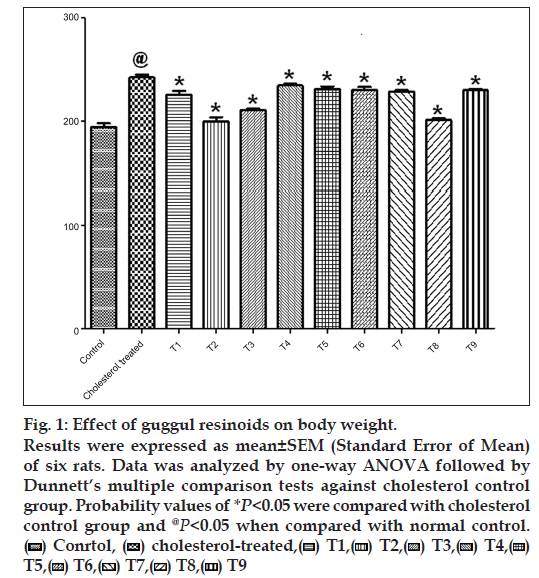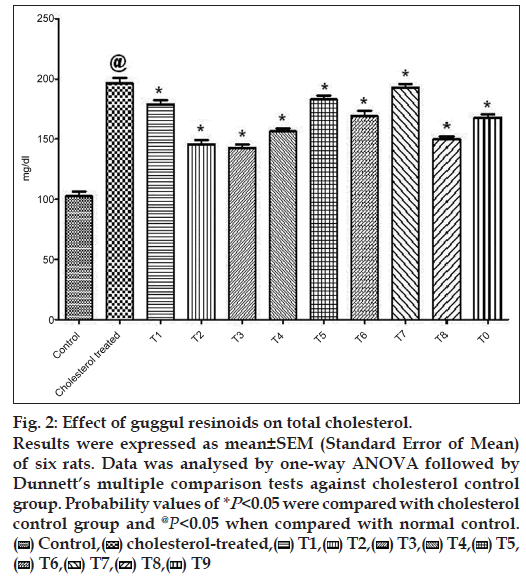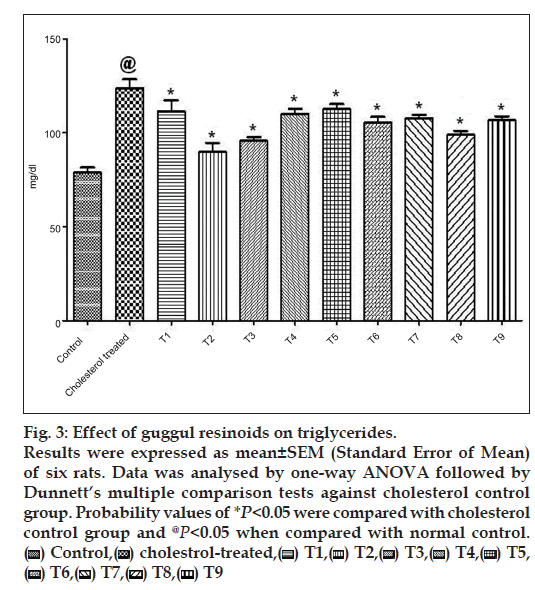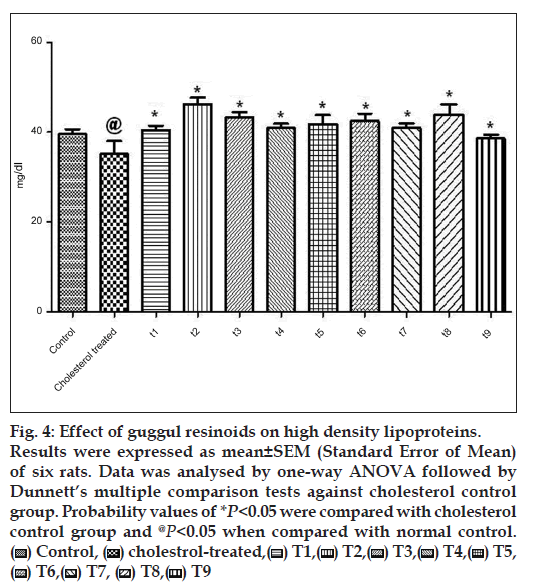- *Corresponding Author:
- M. Z. Siddiqui
Processing and Product Development Division, Indian Institute of Natural Resins and Gums, Namkum, Ranchi-834 010, India
E-mail: mzs_2009@rediffmail.com
| Date of Submission | 6 March 2012 |
| Date of Revision | 18 October 2012 |
| Date of Acceptance | 21 October 2012 |
| Indian J Pharm Sci, 2012, 74 (5): 422-427 |
Abstract
The antihyperlipidemic activity of resinoids of guggul (Commiphora mukul/Commiphora wightii), belonging to family Burseraceae (Genus: Commiphora), collected from different parts of India (Gujarat, Madhya Pradesh and Rajasthan), was studied on cholesterolâ??rich high fat diet-induced model of hyperlipidemia in rats. The resinoids of these exudates were prepared in ethyl acetate and ethyl alcohol. The physicochemical characterization of these resinoids was carried out to determine their appearance, %yield, %moisture, %ash, acid value (mg/KOH/g), saponification value (mg/KOH/g), ester value and iodine value (g/g). Antihyperlipidemic study was carried out on all resinoids in high fat diet induced model of hyperlipidemia in Wistar albino rats. The result demonstrated that the resinoids of exudates of Commiphora wightii and Commiphora mukul, collected from Gujarat and extracted in ethyl acetate, and the resinoids of exudates of Commiphora mukul, collected from Madhya Pradesh and extracted in ethyl acetate, possessed significantly higher antihyperlipidemic activity compared with other resinoids, which may be due to regional/geographical variations.
Keywords
Commiphora mukul, Commiphora wightii, guggul, high fat diet model, hyperlipidemia, resinoids, triglycerides
Hyperlipidemia is defined as increase in lipid content in blood and lipid associated disorders which are based not only on total serum cholesterol, but also on the distribution amongst different lipoproteins [1]. The low density lipoproteins (LDL) are the major carriers of cholesterol towards the tissues having atherogenic potential, whereas high density lipoproteins (HDL) carry cholesterol from peripheral tissues to the liver, protecting system from many cardiac problems and obesity [2]. Thus, hyperlipidemia is characterized by elevated levels of LDL and decreased level of HDL in the blood. Hyperlipidemia is the primary risk factor of coronary heart disease and atherosclerotic heart disease [3]. There are wide range of antihyperlipidemic drugs available in the market, but most of them have side‑effects. Herbal medicines are being accepted and used increasingly by general population both in eastern and western countries because of their ethnic acceptability and compatibility, having less side‑effects [4].
Guggul, an oleo gum‑resin, is plant exudates of Commiphora wightii (Arnott.) Bhand./ Commiphora mukul Engl., belonging to family Burseraceae (Genus: Commiphora) and has been in use medicinally since Vedic period for treatment of a number of diseases such as atherosclerosis, hypercholesterolemia, rheumatism, obesity, respiratory diseases, liver disorders, digestive problems, menstrual irregularities [5‑9]. Guggul is a slow growing, highly branched shrub or small tree, reaching a maximum height of 4 m, with thin papery bark. Guggul comprises 61% resin, 29.3% gum, 0.6% volatile oils, 6.1% moisture and 3.2% foreign matter [10]. The resinous parts of Commiphora mukul/Commiphora wightii possess ketonic steroidal compounds Z‑ and E‑guggulsterones (cis‑ and trans‑4,17 (20)‑pregnadiene‑3,16‑dione), and form the active key constituents of guggul [11,12]. Guggul of Commiphora mukul/Commiphora wightii possess lipid lowering effect [13‑15]. In various experimental and human studies, Commiphora mukul has shown to decrease atherosclerosis, lower serum cholesterol and triglycerides (TGs), and also increase HDL and cholesterol [16‑18]. In India the main commercial sources of Commiphora mukul/Commiphora wightii are Gujarat, Madhya Pradesh and Rajasthan. Recently, researchers have observed that there is a wide range of variation in pharmacological activity from the same part of the plant, collected from different regions. Hence, this study aims at examining the antihyperlipidemic activity of guggul collected from different geographical locations in the country.
Materials and Methods
All the chemicals, reagents and solvents used for determination of physicochemical parameters of resinoids of exudates of Commiphora mukul and Commiphora wightii were of analytical grade and purchased from Rankem, New Delhi, India and Merck India Ltd., Mumbai, India.
Thirty male Wistar albino rats (100‑250 g body weight) were used in this study. Animals were procured from Institutional Animal House (Reg No. BIT/PH/IAEC/31/2010/15‑9‑10) of Birla Institute of Technology, Mesra, Ranchi (Jharkhand), India. All animals were kept in polyacrylic cages and maintained under standard housing conditions (room temperature 24‑27º and humidity 60‑65% with 12:12 light:dark cycles). Food was provided in the form of dry pellets and water ad libitum. The animals were allowed to get acclimatized to the laboratory conditions for 7 days before the commencement of the experiment. All experiments involving animals complied with the ethical standards of animal handling and approved by Institutional Animal Ethics Committee.
Guggul collection and extraction
Exudates of Commiphora mukul/Commiphora wightii, commonly known as guggul, were collected from Gujarat, Madhya Pradesh and Rajasthan (India), falling in three different agro‑climatic zones i.e. ‘Gujarat plains and hills region’, ‘Eastern plateau and hills region’ and ‘Western dry region’, respectively. The resinoids of these exudates were prepared in two solvents ethyl acetate (moderately nonpolar) and ethyl alcohol (highly polar) using solvent extraction methods [19,20]. The details of resinoids are: T1: Exudates of Commiphora wightii collected from Gujarat and extracted in ethyl alcohol; T2: Exudates of Commiphora wightii collected from Gujarat and extracted in ethyl acetate; T3: Exudates of Commiphora mukul collected from Gujarat and extracted in ethyl acetate; T4: Exudates of Commiphora mukul collected from Gujarat and extracted in ethyl alcohol; T5: Exudates of Commiphora wightii collected from Rajasthan and extracted in ethyl acetate; T6: Exudates of Commiphora wightii collected from Rajasthan and extracted in ethyl alcohol; T7: Exudates of Commiphora mukul collected from Madhya Pradesh and extracted in ethyl alcohol; T8: Exudates of Commiphora mukul collected from Madhya Pradesh and extracted in ethyl acetate; T9: Residual gum of exudates of Commiphora mukul collected from Madhya Pradesh and extracted in ethyl acetate.
Physicochemical characterization
Physicochemical characterization of resinoids was carried out according to the method described by Association of Official Analytical Chemists [21] to determine their appearance, %yield, %moisture, %ash, acid value (mg/KOH/g), saponification value (mg/ KOH/g), ester value and iodine value (g/g) and are given in Tables 1 and 2.
| Properties | Ethylacetate | Ethyl alcohol | |||
|---|---|---|---|---|---|
| Gujarat | Madhya Pradesh | Gujarat | Madhya Pradesh | ||
| Appearance | Brownish semi-solid | Brownish semi-solid | Brownish semi-solid | Brownish semi-solid | |
| Yield% | 25.0 | 27.0 | 25.0 | 25.0 | |
| Moisture% | 0.61 | 0.58 | 0.64 | 0.58 | |
| Ash% | Sublimed | Sublimed | Sublimed | Sublimed | |
| Acid value (mg/KOH/g) | 11.88 | 10.20 | 15.77 | 13.16 | |
| Saponification value (mg/KOH/g) | 225.36 | 219.94 | 233.94 | 230.32 | |
| Ester value | 213.48 | 209.74 | 218.17 | 217.16 | |
| Iodine value (g/g) | 100.34 | 98.34 | 100.48 | 100.26 | |
Table 1: Physicochemical Values Of The Resinoids Of Commiphora Mukul
| Properties | Ethylacetate | Ethyl alcohol | ||
|---|---|---|---|---|
| Gujarat | Rajasthan | Gujarat | Rajasthan | |
| Appearance | Brown semi-solid | Dark brown semi-solid | Brown semi-solid | Dark brown semi-solid |
| Yield% | 29.0 | 22.0 | 27.0 | 20.0 |
| Moisture% | 0.55% | 0.75 | 0.54 | 0.78 |
| Ash% | Sublimed | 0.58 | Sublimed | 0.65 |
| Acid value (mg/KOH/g) | 6.63 | 15.07 | 8.20 | 14.65 |
| Saponification value (mg/KOH/g) | 222.02 | 252.54 | 235.14 | 270.02 |
| Ester value | 215.39 | 237.47 | 226.94 | 255.37 |
| Iodine value (g/g) | 98.75 | 103.08 | 100.79 | 103.98 |
Table 2: Physicochemical Values Of The Resinoids Of Commiphora Wightii
Protocol for induction of hyperlipidemia and treatment
Antihyperlipidemic activity was studied by first inducing hyperlipidemia in Swiss albino rats with the help of cholesterol‑rich high fat diet (HFD) model. The hyperlipidemic diet consists of 83% rodent chow, 15% coconut oil and 2% cholesterol [22]. The experimental animals were divided into 11 groups with six animals in each group. Group 1: Normal diet control [treated with Tween 80 (5% w/v) orally]; Group 2: Hyperlipidemic control [treated with Tween 80 (5% w/v) orally] and Groups 3‑9: Treated with various resinoids of guggul exudates (250 mg/kg b.w.) T1‑T9, respectively.
Blood sample collection and analysis
On the 28th day, blood was collected by retro‑orbital puncture under mild ether anesthesia from 8 h fasted animals and allowed to clot for 30 min at room temperature. Blood samples were centrifuged at 3000 rpm for 20 min. Serum was separated and refrigerated until biochemical estimations were carried out.
Assessment of biochemical parameters
The main biochemical parameters for lipid screening i.e. total cholesterol (TC), high density lipoprotein cholesterol (HDL‑C) and TGs were evaluated from the serum (National Cholesterol Education Program 2002) [23] using diagnostic kits, procured from Span Diagnostics Ltd., Surat, India. Clinical analyzer‑Systronics 635, Systronic (India) Ltd., Ahmedabad, India, was used for spectrophotometric measurements.
Statistical analysis
Results were expressed as mean±SEM (Standard Error of Mean) of six rats. Data was analysed by one‑way ANOVA followed by Dunnett’s multiple comparison tests against cholesterol control group. Probability values of P<0.05 were compared with cholesterol control group. The statistical analysis was done using the trial version of Graph Pad INSTAT 3.10 software.
Results and Discussion
The physicochemical values of the resinoids of Commiphora mukul from Gujarat and Madhya Pradesh and Commiphora wightii from Gujarat and Rajasthan, both extracted in ethyl acetate and ethyl alcohol, have been given in Tables 1 and 2, respectively. Polarity of the solvents does not have much significant effect on the physico‑chemical properties of the resinoids of guggul, collected from different places. Low %moisture in all the resinoids, irrespective of the solvent and the place, is advantageous in terms of their shelf‑life, enabling preservation for a longer time. Sublimation of the resinoid, while determining the %ash by high temperature incineration in an electric muffle furnace, is an indication of its being devoid of any inorganic minerals. The resinoids of Commiphora wightii from Rajasthan had 0.58 and 0.65 %ash in ethyl acetate (T5) and ethyl alcohol (T6), respectively. Acid value (mg/KOH/g) is an important index of physicochemical properties, being indicative of quality, age, edibility and suitability. The acid value of the resinoid of Commiphora wightii from Gujarat is much less as compared with the resinoid of Commiphora wightii from Rajasthan, which may be due to regional/geographical variations. Saponification value (mg/KOH/g) gives an idea of the average molecular weight or the chain length of all the acids present. Higher the molecular weight, the lower the saponification value, as it has inverse relationship. The saponification value of the resinoid of Commiphora wightii from Rajasthan is higher, which again may be due to regional/geographical variations. Iodine value (g/g) indicates the number of double bonds present and, therefore, the degree of unsaturation. The higher the iodine value, more the double bonds in the molecule. The iodine value of the resinoids of guggul, irrespective of the place and the solvent, shows that there is mono unsaturation in the components of resinoids and falls in the category of nondrying.
Feeding of HFD to the animals was found to increase the bodyweight, TC level and TGs level but decrease the HDL level in the animals. The results of the present study showed that, the guggul resinoids decrease the body weight (fig. 1), TC level, TGs level and increase the level of HDL, when compared with lipidemic control rats (fig. 1).
A HFD increases the cholesterol level, thereby leading to gain in bodyweight and obesity in animals [24]. Treatment with T2, T3 and T8 reduced the body weight significantly (P<0.05) compared to cholesterol control group (Group II) (fig. 1). Next to that, T1, T5, T6, T7 reduced the body weight significantly compared to cholesterol control group (Group II) (fig. 1). The results imply that T2, T3, T8 exudates are active against obesity due to high cholesterol diet.
TC level of disease control group (Group II) was significantly higher than that of normal control animals (fig. 2). Treatment with T2, T3 and T8 reduces the TC level significantly (P<0.05) compared with cholesterol control group (Group II) (fig. 2). In addition to that, T4, T6, T9 reduced the TC level significantly compared to cholesterol control group (Group II) (fig. 2). Remaining exudates did not show any significant action in reducing TC level compared to cholesterol control group.
TGs level of cholesterol control group is higher as compared to that of normal control animals (fig. 3). Increased levels of TGs are solely related to coronary artery diseases [25,26]. Hence, reduction of TG levels is highly important in the management of hyperlipidemia as it is the primary cause of cardio vascular disorders. Treatment with T2, T3, T8 and T9 reduces the TGs level significantly (P<0.05) compared to cholesterol control group (Group II) (fig. 3). Also, T4, T6, T7 reduced the TGs level significantly compared to cholesterol control group (Group II) (fig. 3).
HDL level of cholesterol control group is lower compared to that of normal control animals (fig. 4). It is well known that HDL levels have a protective role in coronary artery disease [27]. Treatment with T1, T2, T3 and T8 increases the HDL level significantly (P<0.05) compared with cholesterol control group (Group II) (fig. 4). In addition to that, T4, T5 and T6 increase the HDL level moderately. From the above results it is proved that the exudates increased the HDL level and decreased the TC level.
The comparative study of antihyperlipidemic activity of guggul (Commiphora mukul/Commiphora wightii) collected from different geographical locations in India demonstrated that the resinoids of exudates of Commiphora wightii and Commiphora mukul collected from Gujarat and extracted in ethyl acetate and the resinoids of exudates of Commiphora mukul collected from Madhya Pradesh and extracted in ethyl acetate possessed significantly higher antihyperlipidemic activity compared to other resinoids. It appears that the bioactive metabolites present in plant extracts are more soluble in ethyl acetate, indicating superior activity than alcohol. However, subsequent studies on fraction level and isolation of active ingredients from these exudates are required to determine the reasons for variation in their activity.
Acknowledgements
The authors are grateful to Dr. R. Ramani, Director, Indian Institute of Natural Resins and Gums, Namkum, Ranchi (Jharkhand), India and Dr. D. Sasmal, Professor and the then Head, Department of Pharmaceutical Sciences, Birla Institute of Technology, Mesra, Ranchi (Jharkhand), India for providing necessary facilities for conducting the study. The technical assistance rendered by Sri D.D. Singh, Senior Technical Officer, in determining physicochemical properties of resinoids, is gratefully acknowledged.
References
- Arshad AO, Gaurav D, Kale MK. Antihyperlipidemic activity of rimonabant on high cholesterol diet induced hyperlipidemia in rats. Pharmacol Online 2011;1:1212-20.
- Sathivel A, Raghavendran HR, Srinivasan P, Devaki T. Antiperoxidative and antihyperlipidemic nature of Ulva lactuca crude polysaccharide on D-galactosamine induced hepatitis in rats. Food Chem Toxicol 2008;46:3262-7.
- Singh BB, Vinjamury SP, Der-Martirosian C, Kubik E, Mishra LC, Shepard NP, et al. Ayurvedic and collateral herbal treatments for hyperlipidemia: A systematic review of randomized controlled trials and quasi-experimental designs. Altern Ther Health Med 2007;13:22-8.
- Balasubramaniam A, Manivannan R, Paramaguru R, Mazumder PM, Vijayakumar M. Evaluation of antiinflammatory and antioxidant activities of stem bark of Toddalia asiatica (L.) Lam using different experimental models. Pharmacology 2012;3:144-9.
- Gujral ML, Saxena K, Tangri KK, Amma MK, Roy AK. Antiarthritic and antiinflammatory activity of gum guggul (Balsamodendron mukul Hook). Indian J Physiol Pharmacol 1960;40:267-73.
- Arora RB, Das D, Kapoor SC, Sharma RC. Effect of some fractions of Commiphora mukul on various serum lipid levels in hypercholesterolemic chicks and their effectiveness in myocardial infarction in rats. Indian J Exp Biol 1973;11:166-8.
- Baldwa VS, Bhasin V, Ranka PC, Mathur KM. Effects of Commiphora mukul (Guggul) in experimentally induced hyperlipemia andatherosclerosis. J Assoc Physicians India 1981;29:13-7.
- Arya VP. Gugulipid. Drugs Future 1988;13:618-9.
- Deng R. Therapeutic effects of guggul and its constituent guggulsterone: Cardiovascular benefits. Cardiovasc Drug Rev 2007;25:375-90.
- Anonymous. The wealth of India (raw material). Vol. 2. New Delhi: CSIR; 1950. p. 313.
- Patil VD, Nayak UR, Dev S. Chemistry of Ayurvedic drugs. I. Guggulu (a resin from C. mukul) steroidal constituents. Tetrahedron 1972;28:2341.
- Purushothaman KK, Chandrasekharan S. Guggul sterols from C. mukul Indian J Chem 1976;14:802.
- Kuppurajan K, Rajagopalan SS, Rao TK, Sitaraman R. Effect of guggulu (Commiphora mukul–Engl.) on serum lipids in obese, hypercholesterolemic and hyperlipemic cases. J Assoc Physicians India 1978;26:367-73.
- Saxena G, Singh SP, Pal R, Singh S, Pratap R, Nath C. Gugulipid, an extract of Commiphora wighitii with lipid-lowering properties, has protective effects against streptozotocin-induced memory deficits in mice. Pharmacol Biochem Behav 2007;86:797-805.
- Siddiqui MZ. Guggul: An excellent herbal panacea–A review. Asian J Pharm Health Sci 2011;1:35-9.
- Verma SK, Bordia A. Effects of Commiphora mukul (gum guggulu) in patients of hyperlipidemia with special reference to HDL cholesterol. Indian J Med Res 1988;87:356-60.
- Singh RB, Niaz MA, Ghosh S. Hypolipidemic and antioxidant effects of Commiphora mukul as an adjunct to dietary therapy in patients with hypercholesterolemia. Cardiovasc Drugs Ther 1994;8:659-64.
- Ulbricht C, Basch E, Szapary P, Hammerness P, Axentsev S, Boon H, et al. Guggul for hyperlipidemia: A review by the Natural StandardResearch Collaboration. Complement Ther Med 2005;13:279-90.
- Uma DP, Ganasoundari A, Rao BS, Srinivasan KK. In vivo radioprotection by Ocimum flavonoids: Survival of mice. Radiat Res 1999;151:74-8.
- Jain A, Gupta VB. Chemistry and pharmacological profile of guggul: A review. Indian J Tradit Knowl 2006;5:478-83.
- Anonymous. Official methods of analysis of the Association of Official Analytical Chemists. 17th ed. Washington, D.C: Association of official Analytical Chemists; 1997.
- Dhanapakiam P, Joseph JM, Ramaswamy VK, Moorthi M, Kumar AS. The cholesterol lowering property of coriander seeds (Coriandrum sativum): Mechanism of action. J Environ Biol 2008;29:53-6.
- National Cholesterol Education Program (NCEP) Expert Panel on Detection, Evaluation, and Treatment of High Blood Cholesterol in Adults (Adult Treatment Panel III). Third Report of the National Cholesterol Education Program (NCEP) Expert Panel on Detection, Evaluation, and Treatment of High Blood Cholesterol in Adults (Adult Treatment Panel III) final report. Circulation 2002;106:3143-421.
- Guido S, Joseph T. Effect of chemically different calcium antagonists on lipid profile in rats fed on a high fat diet. Indian J Exp Biol 1997;30:292.
- El-Hazmi MA, Warsy AS. Evaluation of serum cholesterol and triglycerides levels in 1-6 year old Saudi children. J Trop Pediatr 2001;47:181-5.
- Bainton D, Miller NE, Botton CH, Yarnell JW, Sweetnam PM, Baker IA. Plasma triglycerides and high density lipoprotein cholesterol as predictors of ischaemic heart disease in British men. The caerphilly and speedwell collaborative heart disease studies. Br Heart J 1992;68:60-6.
- Ding ZY, Chen Y, Zhou M, Fang YZ. Inhibitory effect of green tea polyphenol and murin on the oxidative modification of low density lipoprotein. Basic Clin Pharmacol Toxicol 1992;6:263-6.



